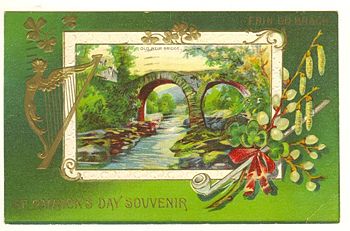St. Patrick’s Day: Should it Be Observed At All?

Postcard from 1912 Honoring “St. Patrick’s Day”
Yesterday, there were several news stories about changing the time of the Catholic celebration of “St. Patrick’s Day” this year.
The following is from one such story from TheDay.com followed by one from the ledger.com both dated 2/22/08:
SOME PLANNING TO TAKE part in the annual Irish revelry that is St. Patrick’s Day are faced this year with a rare dilemma. For the first time since 1940, the day that honors Saint Patrick falls during Holy Week, the seven sacred days before Easter. Because of the overlap, Catholic churches are moving masses in honor of St. Patrick from the usual March 17, as dictated by the church’s liturgical rules.But in some places, such as Savannah, Ga., which draws more than half a million people for its St. Patrick’s Day festivities, Catholic leaders have gone further, asking that celebrations outside the church also be changed.
———————————————————-
Because Easter comes so early this year, St. Patrick’s Day actually falls during Holy Week — the week between Palm Sunday and Easter. Liturgical rules forbid celebrating Mass in honor of the saint, according to a story from the Associated Press. And because ol’ St. Paddy’s day has become such a roisterous affair, Catholic bishops in America are asking that St. Patrick’s Day parades be moved earlier to avoid distracting from the seriousness of the week. According to the AP, civic celebrations will take place on March 14 or 15 in Savannah, Philadelphia and Milwaukee.
However, the above really should get people to think that perhaps this day should not be celebrated at all. (Nor for that matter should Easter be celebrated as it was not observed by early Christians–and its date to was changed by Roman leaders.)
The Catholic Encyclopedia reports some additional, as well as disturbing, details about Patrick:
St. Patrick
Apostle of Ireland, born at Kilpatrick, near Dumbarton, in Scotland, in the year 387; died at Saul, Downpatrick, Ireland…Pope St. Celestine I, who rendered immortal service to the Church by the overthrow of the Pelagian and Nestorian heresies, and by the imperishable wreath of honour decreed to the Blessed Virgin in the General Council of Ephesus, crowned his pontificate by an act of the most far-reaching consequences for the spread of Christianity and civilization, when he entrusted St. Patrick with the mission of gathering the Irish race into the one fold…“St. Patrick’s Breast-Plate”, is supposed to have been composed by him in preparation for this victory over Paganism. The following is a literal translation from the old Irish text:
I bind to myself today
The strong virtue of the Invocation of the Trinity:
I believe the Trinity in the Unity…St. Patrick proceeded through Gowran into Ossory; here he erected a church under the invocation of St. Martin, near the present city of Kilkenny, and enriched it with many precious relics which he had brought from Rome…
Many times in the day he armed himself with the sign of the Cross…
Far more ample, however, were the aspirations of the saint, and he resolved to persevere in fasting and prayer until the fullest measure of his petition was granted. Again and again the angel came to comfort him, announcing new concessions; but all these would not suffice. He would not relinquish his post on the mountain, or relax his penance, until all were granted. At length the message came that his prayers were heard:
many souls would be free from the pains of purgatory through his intercession…and…
greatest blessing of all, Patrick himself should be deputed to judge the whole Irish race on the last day.,
Such were the extraordinary favors which St. Patrick, with his wrestling with the Most High, his unceasing prayers, his unconquerable love of heavenly things, and his unremitting penetential deeds, obtained for the people whom he evangelized (Cardinal Moran, Patrick Francis. Transcribed by Mary Doorley. St. Patrick. The Catholic Encyclopedia, Volume XI. Published 1911. New York: Robert Appleton Company. Nihil Obstat, February 1, 1911. Remy Lafort, S.T.D., Censor. Imprimatur. +John Cardinal Farley, Archbishop of New York).
We in the Living Church of God do not consider that Patrick was an apostle. We do not consider that people should wear crosses. We do not believe that Patrick has been chosen by God to judge the Irish race on judgment day.
As most Protestants do not believe that God has given the power to judge the Irish to Patrick, they too should not celebrate this Roman Catholic holiday.
An article of related interest would be Why The Church of God Does Not Wear Green on St. Patrick’s Day.
 |
Tweet |
|